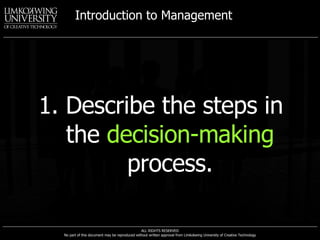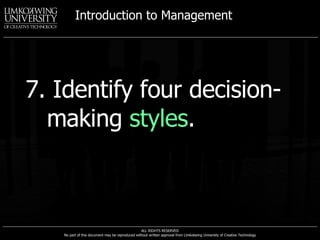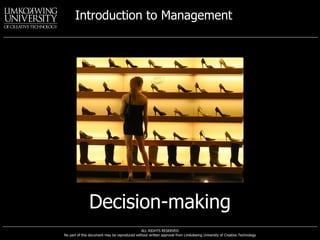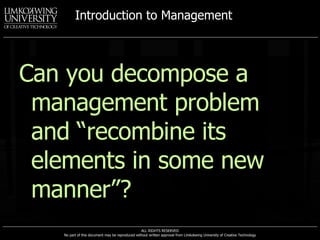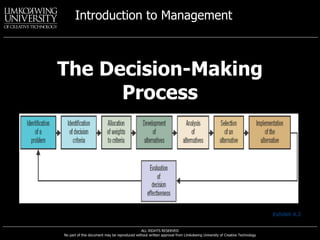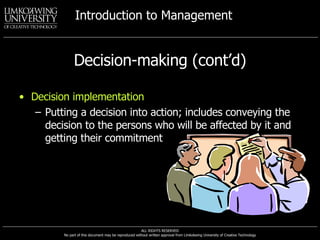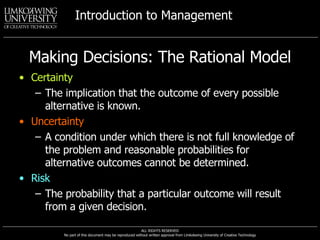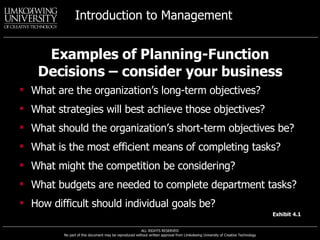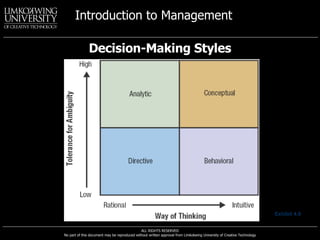Day4
- 1. PART II: Planning 4
- 2. Learning Outcomes After this class, I will be able to:
- 3. 1. Describe the steps in the decision-making process.
- 4. 2. Identify the assumptions of the rational decision-making model.
- 5. 3. Explain the limits to rationality .
- 6. 4. Describe the actions of the bounded-rational decision maker.
- 7. 5. Identify the two types of decision problems and the two types of decisions that are used to solve them.
- 8. 6. Define heuristics and explain how they affect the decision-making process.
- 9. 7. Identify four decision-making styles .
- 10. 8. Describe the advantages and disadvantages of group decisions.
- 11. 9. Explain three techniques for improving group decision making.
- 12. Decision-making
- 13. Staple or Paper Clip? Book or Movie? Friend or Foe? Apple or Orange? Good or Evil? Healthy or Unhealthy? Work or Play? Attack or Defend? Transparent or Fake? Positive or Negative? Freedom or Confinement? Bible or Football? Computer or Compassion?
- 16. Decision-making
- 17. Can you decompose a management problem and “recombine its elements in some new manner”?
- 18. Strategy is all about choice, which affects outcomes.
- 19. Strategy is differentiated from tactics or immediate actions with resources at hand by its nature of being extensively premeditated, and often practically rehearsed. Strategies are used to make the problem easier to understand and solve.
- 20. Examples of Planning-Function Decisions What are the organization’s long-term objectives? What strategies will best achieve those objectives? What should the organization’s short-term objectives be? What is the most efficient means of completing tasks? What might the competition be considering? What budgets are needed to complete department tasks? How difficult should individual goals be? Exhibit 4.1
- 21. Decision-making process A set of eight steps that includes identifying a problem, selecting a solution, and evaluating the effectiveness of the solution Problem A discrepancy between an existing and a desired state of affairs Decision criteria Factors that are relevant in a decision
- 22. The Decision-Making Process Exhibit 4.2
- 23. Criteria and Weight in Car-Buying Decision (Scale of 1 to 10) CRITERION WEIGHT Price 10 Interior comfort 8 Durability 5 Repair record 5 Performance 3 Handling 1 Exhibit 4.3
- 24. Assessment of Car Alternatives Exhibit 4.4
- 25. Weighting of Vehicles (Assessment Criteria X Criteria Weight) Exhibit 4.5
- 26. Decision-making (cont’d) Decision implementation Putting a decision into action; includes conveying the decision to the persons who will be affected by it and getting their commitment to it.
- 27. Making Decisions: The Rational Model Certainty The implication that the outcome of every possible alternative is known. Uncertainty A condition under which there is not full knowledge of the problem and reasonable probabilities for alternative outcomes cannot be determined. Risk The probability that a particular outcome will result from a given decision.
- 28. Assumptions of Rationality Exhibit 4.6
- 29. What Is Creative Potential? Expertise Understanding, abilities, knowledge, proficiencies, necessary in the field of creative endeavor. Creative-thinking skills The personality characteristics associated with creativity, the ability to use analogies, as well as the talent to see the familiar in a different light. Intrinsic task motivation The desire to work on something because it’s interesting, involving, exciting, satisfying, or personally challenging.
- 30. Three Elements of Creativity Creativity The ability to produce novel and useful ideas Exhibit 4.7 Source: T. M. Amabile. “Motivating Creativity in Organizations,” Califormia Management Review (Fall 1997), p. 43. Copyright © 1997, by The Regents of the University of California. Reprinted by permission of the Regents.
- 31. Making Decisions: The Rational Model Rational Describes choices that are consistent and value-maximizing within specified constraints. Bounded rationality (Herbert Simon) Behavior that is rational within the parameters of a simplified model that captures the essential features of a problem. Satisfice Making a “good enough” decision: choosing the first-identified alternative that satisfactorily and sufficiently solves the problem.
- 32. Common Decision-making Errors Heuristics: Using judgmental shortcuts Availability heuristic The tendency to base judgments on information that is readily available. Representative heuristic The tendency to base judgments of probability on things (objects or events) that are familiar Escalation of commitment An increased commitment to a previous decision despite negative information about the decision’s present outcomes.
- 33. How Do Problems Differ? Well-structured problems Straightforward, familiar, easily defined problems Ill-structured problems New problems in which information is ambiguous or incomplete Programmed decision A repetitive decision that can be handled by a routine approach Nonprogrammed decisions Decisions that must be custom-made to solve unique and nonrecurring problems
- 34. Programmed Decision-Making Aids Policy A general guide that establishes parameters for making decisions about recurring problems. P rocedure A series of interrelated sequential steps that can be used to respond to a well-structured problem (policy implementation). Rule An explicit statement that tells managers what they ought or ought not to do (limits on procedural actions).
- 35. Examples of Planning-Function Decisions – consider your business What are the organization’s long-term objectives? What strategies will best achieve those objectives? What should the organization’s short-term objectives be? What is the most efficient means of completing tasks? What might the competition be considering? What budgets are needed to complete department tasks? How difficult should individual goals be? Exhibit 4.1
- 36. Types of Problems, Types of Decisions, and Level in the Organization Exhibit 4.8
- 37. Technology And Decision Making Expert systems Software that acts like an expert in analyzing and solving ill-structured problems Use specialized knowledge about a particular problem area rather than general knowledge Use qualitative reasoning rather than numerical calculations Perform at a level of competence higher than that of nonexpert humans. Neural networks Software that is designed to imitate the structure of brain cells and connections among them
- 38. Decision Making: Styles Directive style Characterizes the low tolerance for ambiguity and a rational way of thinking of individuals who are logical and efficient and typically make fast decisions that focus on the short term. Analytic style Characterizes the high tolerance for ambiguity combined with a rational way of thinking of individuals who prefer to have complete information before making a decision.
- 39. Decision Making: Styles (cont’d) Conceptual style Individuals who tend to be very broad in outlook, to look at many alternatives, and to focus on the long run and often look for creative solutions. Behavioral style Individuals who think intuitively but have a low tolerance for uncertainty; they work well with others, are open to suggestions, and are concerned about the individuals who work for them.
- 40. Decision-Making Styles Exhibit 4.9
- 41. Group Decision Making Advantages Make more accurate decisions Provides more complete information Offers a greater diversity of experiences and perspectives Generates more alternatives Increases acceptance of a solution Increases the legitimacy of a decision. Disadvantages Is more time-consuming and less efficient Minority domination can influence decision process Increased pressures to conform to the group’s mindset (groupthink) Ambiguous responsibility for the outcomes of decisions
- 42. When Are Groups Most Effective? Creativity Groups tend to be more creative than individuals. Acceptance of the final solution Groups help increase the acceptance of decisions. Effectiveness of group decision making Groups of five to seven members are optimal for decision process speed and quality.
- 43. Improving Group Decision Making Brainstorming An idea-generating process that encourages alternatives while withholding criticism. Nominal group technique A decision-making technique in which group members are physically present but operate independently. Electronic meeting A type of nominal group technique in which participants are linked by computer.



